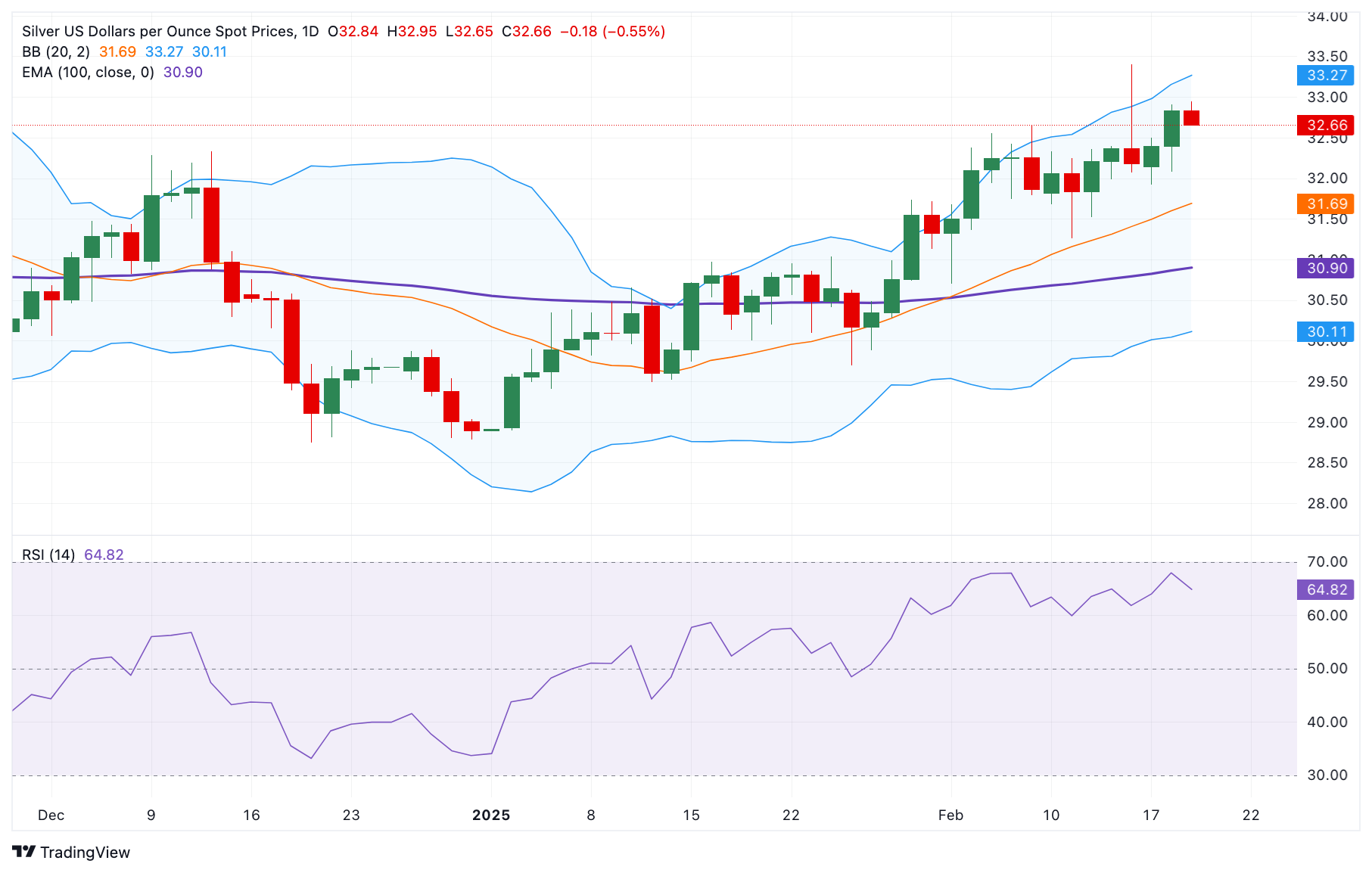Silver Price Forecast: XAG/USD remains constructive above $32.50
- Silver price edges lower to $32.75 in Wednesday’s Asian session.
- The constructive outlook of Silver remains in play above the 100-day EMA with the bullish RSI indicator.
- The first upside barrier emerges at the $33.30-$33.40 region; the initial support level is located at $31.79.
Silver price (XAG/USD) attracts some sellers to near $32.75 during the Asian trading hours on Wednesday. The downside for the white metal might be limited amid the policy uncertainty, including tariff fears under US President Donald Trump’s administration. Later on Wednesday, the FOMC Minutes will be in the spotlight.
According to the daily chart, Silver keeps a bullish vibe at present as the price is well-supported above the key 100-day Exponential Moving Average (EMA). Furthermore, the upward momentum is supported by the 14-day Relative Strength Index (RSI), which is located above the midline near 66.30, suggesting that the path of least resistance is to the upside.
The immediate resistance level for Silver price emerges in the $33.30-$33.40 zone, representing the upper boundary of the Bollinger Band and the high of February 14. Any follow-through buying above this level could expose $34.55, the high of October 29, 2024. The next hurdle to watch is $34.87, the high of October 22, 2024.
On the other hand, the first downside target of the white metal is seen at $31.79, the low of February 7. The crucial contention level is located at the $31.00-$30.90 region, portraying the round mark and the 100-day EMA. Extended losses below the mentioned level could pave the way to $29.70, the low of January 27.
Silver price (XAG/USD) daily chart
Silver FAQs
Silver is a precious metal highly traded among investors. It has been historically used as a store of value and a medium of exchange. Although less popular than Gold, traders may turn to Silver to diversify their investment portfolio, for its intrinsic value or as a potential hedge during high-inflation periods. Investors can buy physical Silver, in coins or in bars, or trade it through vehicles such as Exchange Traded Funds, which track its price on international markets.
Silver prices can move due to a wide range of factors. Geopolitical instability or fears of a deep recession can make Silver price escalate due to its safe-haven status, although to a lesser extent than Gold's. As a yieldless asset, Silver tends to rise with lower interest rates. Its moves also depend on how the US Dollar (USD) behaves as the asset is priced in dollars (XAG/USD). A strong Dollar tends to keep the price of Silver at bay, whereas a weaker Dollar is likely to propel prices up. Other factors such as investment demand, mining supply – Silver is much more abundant than Gold – and recycling rates can also affect prices.
Silver is widely used in industry, particularly in sectors such as electronics or solar energy, as it has one of the highest electric conductivity of all metals – more than Copper and Gold. A surge in demand can increase prices, while a decline tends to lower them. Dynamics in the US, Chinese and Indian economies can also contribute to price swings: for the US and particularly China, their big industrial sectors use Silver in various processes; in India, consumers’ demand for the precious metal for jewellery also plays a key role in setting prices.
Silver prices tend to follow Gold's moves. When Gold prices rise, Silver typically follows suit, as their status as safe-haven assets is similar. The Gold/Silver ratio, which shows the number of ounces of Silver needed to equal the value of one ounce of Gold, may help to determine the relative valuation between both metals. Some investors may consider a high ratio as an indicator that Silver is undervalued, or Gold is overvalued. On the contrary, a low ratio might suggest that Gold is undervalued relative to Silver.




